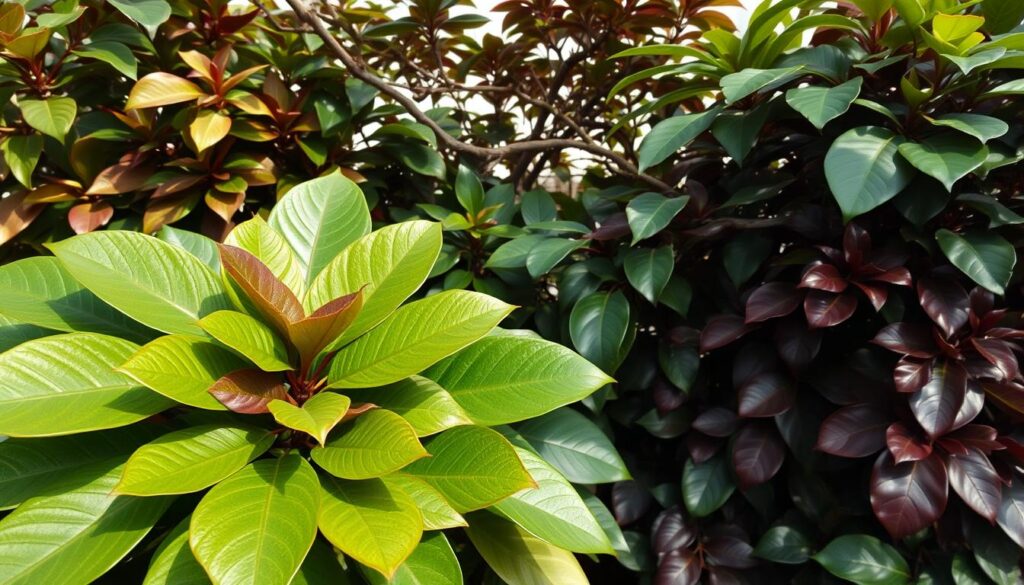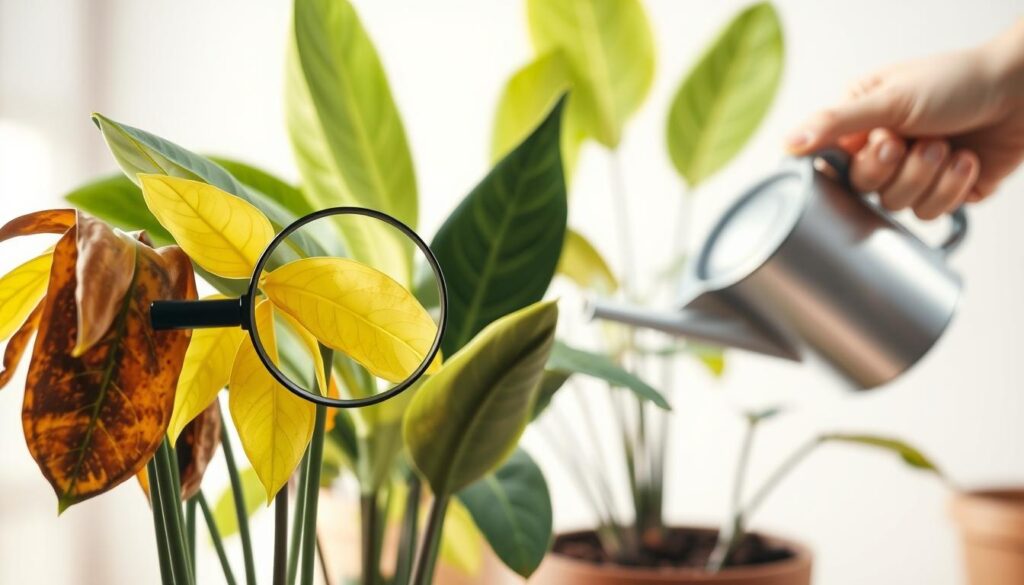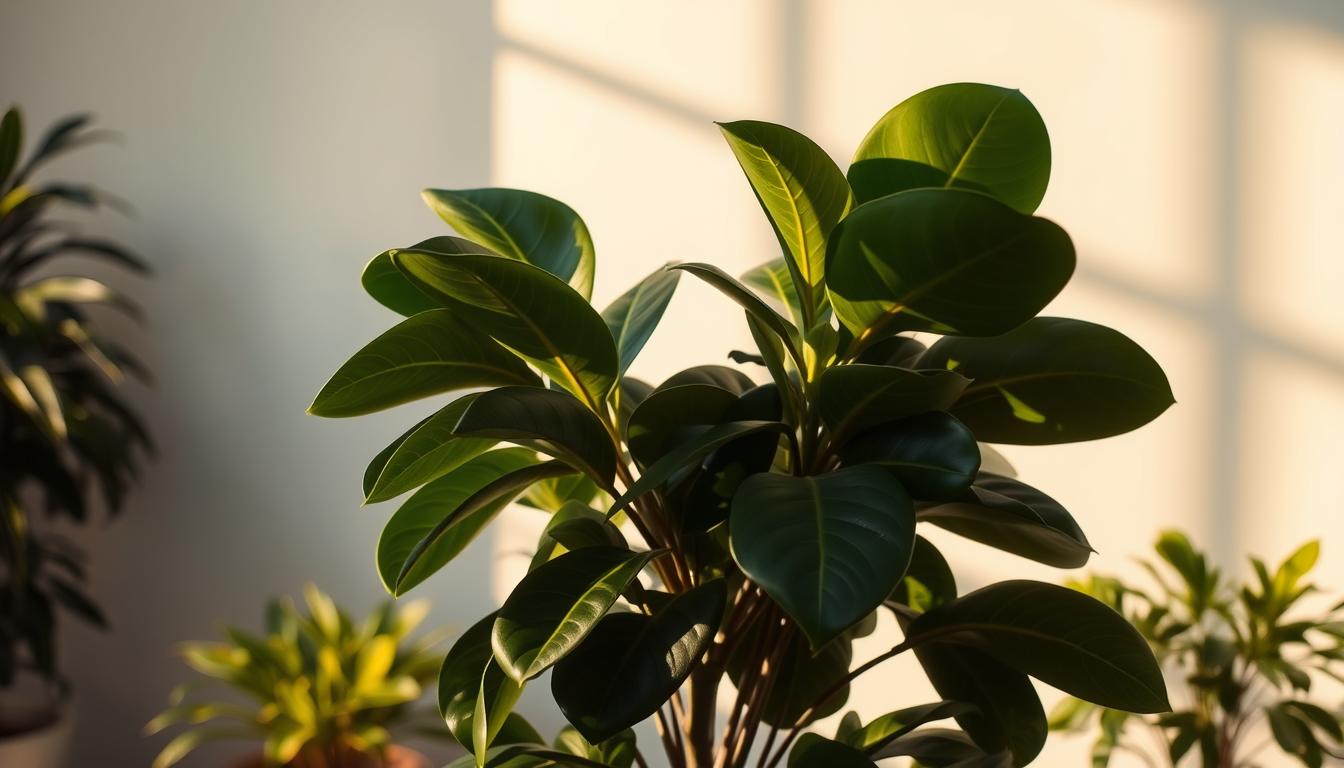The first time I brought home my rubber tree plant, I was captivated by its dramatic, glossy leaves. They seemed to transform my living space instantly. As a cherished indoor plant, the ficus elastica isn’t just another green companion – it’s a statement piece that breathes life into any room.
Native to Southeast Asia, the rubber tree plant has become a beloved houseplant. It’s popular among plant enthusiasts looking for attractive, low-maintenance greenery. Its eye-catching look and air-purifying abilities make it a favorite for homes and offices nationwide.
Whether you’re a seasoned plant parent or a newcomer to indoor gardening, this guide will unlock the secrets to helping your rubber tree plant thrive. Get ready to discover five incredible tips that will elevate your plant care game and transform your indoor space.
Table of Contents
Understanding the Rubber Tree Plant’s Origins
Explore the amazing story of rubber tree plants. These tropical plants have moved from being industrial resources to beloved houseplants. Their journey spans continents and cultures, showing how plants and humans interact.
Rubber tree plants come from the lush landscapes of Southeast Asia. Places like India, Nepal, and Indonesia are their home. These plants have a story that goes beyond just being decorations.
Native Habitat and Natural Growth Patterns
In their natural setting, rubber trees grow well in dense, humid tropical forests. They thrive in areas with:
- Forest canopies
- Warm temperatures
- High humidity
- Near water sources
Historical Significance and Uses
The rubber tree’s role in history is huge. Indigenous communities first used them for latex. This latex was key for:
- Industrial making
- Waterproofing
- Creating important products
Modern Popularity as a Houseplant
Now, rubber tree plants are popular houseplants. They are low-maintenance and attractive indoor plants, making them favorites among those who love tropical plants.
The rubber tree: A testament to nature’s remarkable ability to thrive in diverse environments.
Essential Light Requirements for Optimal Growth
Knowing what light your rubber tree plant needs is key to keeping it healthy. These plants can handle different indoor lights, but they have their favorites. These preferences affect how well they grow and look.
Rubber tree plants love bright, indirect light. They do best near a window with filtered sunlight. Direct sunlight can burn their leaves, making them turn brown and lose color.
- Ideal light conditions: Bright, indirect sunlight
- Avoid: Direct, harsh sunlight
- Acceptable: Low-light plant environments with moderate illumination
Different rubber tree plants need different amounts of light. Variegated rubber plants, for example, need more light to keep their colors bright. If your plant’s leaves start to look pale or lose their green color, it might not have enough light.
Here are some tips to help your plant grow well:
- Place near east or west-facing windows
- Use sheer curtains to filter intense sunlight
- Rotate your plant periodically for even light distribution
Even though rubber trees can handle low light, they grow best in brighter spots. Look out for signs like long, thin leaves or leaves falling off. These signs mean your plant needs more light.
Water and Humidity: Creating the Perfect Balance
Learning to care for a rubber plant means getting the water and humidity just right. These plants are great at handling dry spells but need the right amount of moisture. How you water can decide if your plant thrives or struggles.
Rubber tree plants need specific amounts of water based on their surroundings. They do best with a watering plan that matches their natural home.
Proper Watering Techniques
- Check soil moisture by inserting your finger 2-3 inches deep
- Water only when the top layer of soil feels dry
- Use room temperature water to prevent shock
- Ensure proper drainage to prevent root rot
Humidity Management Tips
Rubber plants love a humid environment. To create the best conditions, try these tips:
- Use a humidity tray near the plant
- Mist leaves occasionally during dry seasons
- Group plants together to increase ambient moisture
- Consider a small humidifier for consistent humidity
Signs of Water-Related Issues
Keep an eye out for these signs of water problems in your rubber plant:
- Yellowing leaves: Possible overwatering
- Drooping leaves: Likely underwatering
- Brown leaf edges: Humidity is too low
- Soft, mushy stems: Severe overwatering risk
By following these care tips, you’ll make sure your rubber plant is happy and healthy.
Soil and Fertilization Guidelines
Starting with the right soil and fertilization is key to caring for your rubber plant. It needs soil that’s similar to its natural home. The right potting mix is essential for its growth and leaf color.
The best soil for your rubber plant is one that drains well and is rich in organic matter. You should look for a high-quality mix that includes:
- Peat moss for moisture retention
- Perlite to improve drainage
- Pine bark for additional nutrient support
Fertilizing your rubber plant is important for its health. In the growing season (spring and summer), give it nutrients that help it grow strong.
| Season | Fertilization Frequency | Recommended Fertilizer |
|---|---|---|
| Spring/Summer | Every 4-6 weeks | Balanced liquid houseplant fertilizer |
| Fall/Winter | Reduce or stop fertilizing | No fertilizer needed |
Pro tip: Always dilute your fertilizer to half the recommended strength to prevent root burn and nutrient overload.
“The secret to a thriving rubber plant is understanding its soil and nutrition needs.” – Plant Care Experts
Look out for signs like yellow leaves or slow growth. These can mean you need to adjust your care routine. This will help keep your plant healthy and looking great.
Temperature and Environmental Conditions
Creating the perfect environment for your indoor plants, especially tropical plants like rubber tree plants, requires careful attention to temperature and climate conditions. Rubber trees are sensitive to environmental changes and thrive when their living space mimics their natural habitat.
Ideal Temperature Range for Healthy Growth
Rubber tree plants prefer a stable temperature zone between 60–75°F (15–24°C). This range closely reflects their tropical origins and supports optimal growth. Sudden temperature fluctuations can stress the plant, causing leaf drop or stunted development.
- Maintain consistent indoor temperatures
- Avoid placing near air conditioning vents
- Keep away from drafty windows
Protecting from Environmental Stress
Your tropical plants are vulnerable to extreme conditions. Cold drafts and sudden temperature shifts can cause significant damage to rubber tree plants. Protect your plant by creating a stable microclimate that shields it from temperature extremes.
“The key to successful indoor plant care is understanding and mimicking natural environmental conditions.” – Plant Care Expert
Seasonal Care Adjustments
Different seasons demand unique care strategies for your indoor plants. During winter, move rubber tree plants away from cold windows and reduce drafts. In summer, ensure they’re not exposed to direct, intense sunlight or extreme heat.
- Winter: Reduce watering, increase humidity
- Summer: Provide indirect light, moderate temperatures
- Spring/Fall: Monitor and adjust care routinely
Stunning Rubber Tree Plant Varieties

Exploring the perfect Ficus elastica for your indoor plants is exciting. Each variety adds unique traits that can turn your home into a lush oasis.
Rubber trees come in a variety of types to choose from:
- Ficus elastica ‘Robusta’: A classic with deep green, glossy leaves that stand out in any room
- Ficus elastica ‘Burgundy’: Has dark red to burgundy leaves that add a pop of color
- Ficus elastica ‘Tineke’: Shows off variegated leaves with cream and green patterns
- Ficus elastica ‘Ruby’: Offers pink and red leaf variations that grab attention
When picking a rubber tree, think about your space, light, and style. Some grow big and need lots of room. Others stay small and fit in tight spots.
“Each rubber tree variety is a living piece of art, bringing nature’s beauty directly into your home.” – Plant Enthusiast
Pro tip: Learn each variety’s care needs to make sure your Ficus elastica does well. They may require varying levels of light, water, and humidity.
Pruning and Maintenance Techniques
Learning to care for a rubber plant means mastering pruning. Your rubber tree needs careful maintenance to stay healthy and look good. Pruning helps control growth, makes the plant bushier, and keeps it looking great.
Pruning your rubber plant is key for its health, not just its looks. Taking off dead or damaged leaves stops diseases and encourages new growth.
Strategic Pruning Methods
- Cut just above leaf nodes to encourage branching
- Remove yellow or brown leaves immediately
- Use clean, sharp pruning shears
- Prune during active growing seasons (spring and summer)
Shape Management Techniques
To control your rubber plant’s shape, you need to prune carefully. Selective trimming helps keep the plant at the right height and width, stopping it from growing too much.
| Pruning Goal | Technique | Frequency |
|---|---|---|
| Height Control | Cut top growth | Every 6-12 months |
| Density Increase | Trim side branches | Annually |
| Shape Refinement | Selective branch removal | As needed |
Tools and Timing Considerations
Get good, sterilized pruning tools to keep your rubber plant safe from infections. Use alcohol-based disinfectants to clean tools between cuts. This keeps the pruning process healthy.
Pro tip: Always make clean, angled cuts to promote faster healing and reduce stress on your rubber plant.
Repotting and Root Care
Caring for your rubber tree houseplants means watching their roots and knowing when to repot. Repotting at the right time can greatly improve your plant’s health and growth.
Most rubber tree plants need a new home every 2-3 years. Look for these signs to know it’s time:
- Roots growing through drainage holes
- Soil dries out quickly after watering
- Plant growth sis lowing down
- The plant is becoming top-heavy or unstable
When selecting a new pot, opt for one that’s just a bit larger than the previous one. A pot that’s too big can cause water to stay and lead to root rot.
“The right pot is like a perfect home – not too small, not too large, but just right.” – Plant Care Experts
Here’s how to repot your rubber tree:
- Gently remove the plant from its current pot
- Check the roots and trim any that are damaged or circling.
- Place fresh potting mix in the new container
- Position the plant and fill with additional soil
- Water thoroughly after repotting
Understanding your rubber tree’s repotting needs is key to a healthy plant. This way, your indoor space will stay beautiful for years.
Common Problems and Solutions
Keeping a rubber tree plant healthy needs careful attention and quick action. Even with good intentions, problems can arise. Knowing these issues helps keep your plant looking great.

Recognizing and fixing common problems early is key. Plant experts say early detection is crucial for plant health.
Pest Management Strategies
Pests can harm your rubber plant fast. Look out for these pests:
- Spider mites: Small insects that produce delicate webs on leaves.
- Mealybugs: White, cottony clusters near leaf joints
- Scale insects: Tiny, hard bumps found on stems and leaves.
Effective Disease Prevention
To prevent diseases, keep your rubber plant clean and in good condition. Good hygiene and the right environment help a lot.
| Disease | Symptoms | Prevention |
|---|---|---|
| Root Rot | Yellowing leaves, soft stems | Ensure proper drainage, avoid overwatering |
| Fungal Infections | Dark spots on leaves | Maintain good air circulation |
Leaf Issues Troubleshooting
Leaf problems can mean different things for your rubber plant. Watch for these signs:
- Yellowing leaves: Often indicate overwatering or nutrient deficiency
- Brown leaf edges: Potential signs of low humidity or mineral buildup
- Leaf drop: Could signal stress from temperature changes or inadequate light
“A healthy rubber plant is a resilient plant. Pay attention to its signals and respond promptly.” – Plant Care Experts
Pro tip: Regular inspection and immediate action are crucial in rubber plant care. Catch potential problems early to maintain your plant’s health and appearance.
Propagation Methods and Success Tips
Starting a new rubber tree plant is thrilling for those who love indoor plants. Propagation lets you make new plants from ones you already have. This way, you can grow your indoor green family without spending a lot.
There are two main ways to propagate rubber tree plants: stem cuttings and air layering. Both can work well if you know the important steps and when to do them.
Stem Cutting Propagation
- Choose a healthy stem that has at least two leaf nodes.
- Cut a 6-8 inch section using clean, sharp pruning shears
- Remove lower leaves, leaving 2-3 top leaves intact
- Dip the cut end in rooting hormone to improve the chances of success.
Optimal Propagation Conditions
| Factor | Ideal Condition |
|---|---|
| Temperature | 70-80°F (21-27°C) |
| Humidity | 60-70% |
| Light | Bright, indirect sunlight |
Pro tip: The ideal time to propagate rubber tree plants is during their active growing season, usually in spring and early summer. This ensures faster root development and higher success rates for your indoor plants.
“Patience is key in plant propagation. Give your new rubber tree plant time to establish roots and grow.” – Plant Propagation Expert
Learning these propagation techniques can turn one rubber tree plant into many thriving indoor plants. This will make your home a lush green oasis.
Air Purification Benefits and Indoor Air Quality
Rubber tree plants are amazing at cleaning the air in your home. They quietly remove harmful toxins, making your living space healthier.
Studies show rubber plants are great at cleaning the air. They get rid of dangerous stuff like:
- Formaldehyde
- Benzene
- Trichloroethylene
- Carbon monoxide
To get the most out of your rubber plant, place it correctly. Put it in a spot with good light and air flow. The bigger the plant, the more toxins it can clean.
Here are some tips to boost air purification:
- Keep leaves dust-free for optimal performance
- Maintain consistent humidity levels
- Ensure proper plant health through regular care
Expert studies suggest that a single rubber plant can significantly improve indoor air quality, potentially removing up to 60% of airborne toxins in a medium-sized room.
Nature’s own air purification system is right in your living room!
Conclusion
Your journey with the rubber tree plant is just starting. These plants are easy to care for and can make your home look great. You now know how to keep your plant thriving and looking great.
The rubber tree plant is perfect for anyone who loves plants. It’s great for cleaning the air or adding style to your room. Just remember, being patient and consistent is key to growing a strong plant.
Keep up the good work with your plant care. Each leaf and new growth reflects your commitment to creating a green home. Your rubber tree will thank you with beautiful leaves and cleaner air.
Enjoy the process of caring for your plant. Watch it grow and thrive with your help. Your indoor garden will show off your new plant skills.
FAQ
Are rubber tree plants toxic to pets?
Yes, rubber tree plants are toxic to cats and dogs. The plant’s milky sap can irritate if eaten. Keep these plants away from pets and kids to avoid health problems.
How frequently should I water my rubber tree plant?
Water your rubber tree when the top 1-2 inches of soil feel dry. This is usually every 1-2 weeks, based on humidity and light. Always check the soil before watering to prevent root rot.
Can rubber tree plants grow in low light?
Rubber tree plants can handle low light but prefer bright, indirect light. In dim light, they may grow tall and lose color. Place them near a window with filtered light for best growth.
How do I prevent my rubber tree plant from getting too tall?
Regular pruning keeps your rubber tree plant from getting too tall. Use sharp shears to trim the top for bushier growth. You can also use the cut stems to grow new plants.
Why are the leaves of my rubber tree plant dropping?
Leaf drop can be caused by several things, like sudden temperature changes, drafts, or inconsistent watering. It can also be due to low humidity or not enough light. Find the cause and adjust your care to stop more leaves from falling.
How frequently should I fertilize my rubber tree plant?
Fertilize your rubber tree in spring and summer once a month with a balanced fertilizer. Cease fertilizing in the fall and winter when the plant’s growth slows down.
Can I propagate a rubber tree plant at home?
Yes, you can propagate rubber tree plants through stem cuttings or air layering. Stem cuttings are the most common method. Take a 6-8 inch cutting, remove lower leaves, and place it in water or a well-draining potting mix to root.
Do rubber tree plants help purify indoor air?
Yes, rubber tree plants are great at purifying indoor air. They can remove toxins like formaldehyde, making them good for your home or office.
What is the best temperature for a rubber tree plant?
Rubber tree plants like temperatures between 60-75°F (15-24°C). Avoid cold temperatures or sudden changes, as they can stress the plant.
How do I treat pest problems on my rubber tree plant?
Common pests include spider mites, mealybugs, and scale insects. Treat infestations by wiping leaves with neem oil, using insecticidal soap, isolating the plant, and keeping it clean. Regular checks help catch and solve pest problems early.

